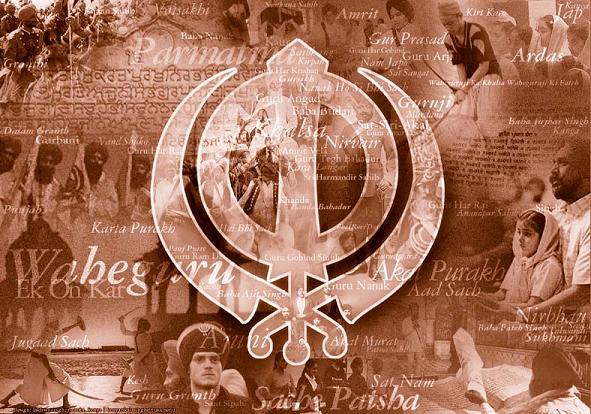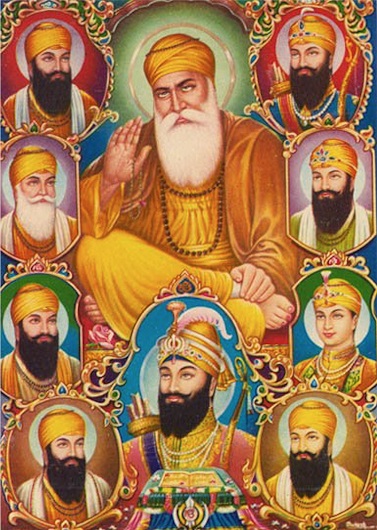Seva is a distinct and unique feature of Sikhism. The highest service according to Sikh religion is service of mankind. Seva in Sikhism means selfless and voluntary service for the benefit of humanity without any personal gain. Seva enjoins a Sikh to promote the welfare of his fellow beings. Seva is an activity that is not recognized as an individual action for self aggrandizement or glory. According to Sikh tradition , service is regarded as part of supreme worship. The Sikh Gurus enjoined upon their followers to serve the humanity. This concept brings physical, mental and spiritual relief to the troubled persons. Voluntary service without expectation of any reward is a path to spiritual attainment provided such service does not create Haumai.

Who can do Seva ?
“He alone performs Guru’s Seva whom the Lord Himself causes so to perform.”Guru Amar Das, who was a great servitor says,
ਗੁਰ ਕੀ ਸੇਵਾ ਸੋ ਕਰੇ ਜਿਸੁ ਆਪਿ ਕਰਾਏ ॥
(421)
“The service of the True Guru is hard. It is obtained by surrendering one’s head and by eliminating self-conceit.”
ਸਤਗੁਰ ਕੀ ਸੇਵਾ ਗਾਖੜੀ ਸਿਰੁ ਦੀਜੈ ਆਪੁ ਗਵਾਇ ॥
(27)
Motto of Seva
Service of humanity is motto of Sikhism. It is a knot that ties us with each other, rather ties us with the Guru. It cleanses the individual consciousness to the expansive nature of universal consciousness. In fact Guru Nanak Dev Ji gave guidelines to the Sikhs to serve those who were less fortunate, sufferers and down trodden.
This service could be social, physical, spiritual or security service for the welfare of the humanity.
Guru Nanak Dev Ji started the Seva by constructing Dharamsalas and providing free Langar irrespective of caste, color or creed on the basis of equality.
Guru Nanak Dev says,
“Do Seva and service in this world and find a seat in the court of God”
ਵਿਚਿ ਦੁਨੀਆ ਸੇਵ ਕਮਾਈਐ ॥
ਤਾ ਦਰਗਹ ਬੈਸਣੁ ਪਾਈਐ ॥
( Sri Rag M-1, 26 )
“Morality without religion is a tree without roots,
Religion without morality is a tree without fruits.”
or
“Simran without Seva is tree without roots.”
Guru Amar Das Ji says,
“Fruitful is the True Guru’s service, if anyone performs it by engaging his mind in it.”
ਸਤਿਗੁਰ ਕੀ ਸੇਵਾ ਸਫਲੁ ਹੈ ਜੇ ਕੋ ਕਰੇ ਚਿਤੁ ਲਾਇ ॥
(644)
Important precautions behind Seva in Sikhism
The teachings of Sikhism do not want a Sikh to behave as benefactor of the poor. It emphasis that the principle of Wand Chhakna should be considered as Shukrana of the Creator. The Sikh should feel that it is his duty to serve the needy, sick and poor. He should not take pride to have served the less fortunate as their benefactor and protector.
-
“Mortal does less Seva but demands much more.”
ਸੇਵਾ ਥੋਰੀ ਮਾਗਨੁ ਬਹੁਤਾ ॥
(738)
- Seva in Sikhism means selfless service without personal motive.
- In Seva there is no discrimination on the basis of caste, color and creed.
- Seva must be done without any Haumai and not for self aggrandizement or glory.
- Seva must not be performed to burden the beneficiary so as to make him feel indebted.
- Seva must not be performed for any award, reward or recognition except for service to God.
- Seva must not be for show but intended to inculcate humility and love for God.
- Seva must be for inculcation of Sat, Santokh,Sahaj and Daya.
Sat santokh Daya dharam eh sigar banwoun,
Safal suhagan Nanka apne prabh bhavoun.
Let me be bedecked with truth, contentment and justice(Dharma) so that I can become a successful Suhagan (Dear beloved) of the Lord and be loved by Him.
Example of Seva set by the Gurus and the Gursikhs
Guru Nanak Dev says,
“Cutting off my head, I will give it to Him to sit on, and without head, I will perform His service.”
ਸੀਸੁ ਵਢੇ ਕਰਿ ਬੈਸਣੁ ਦੀਜੈ ਵਿਣੁ ਸਿਰ ਸੇਵ ਕਰੀਜੈ ॥
(558)
The Sikh Gurus preached what they did practically in their lives. All the Sikh Gurus set examples of Seva and thus they became the models for their followers. Guru Nanak Dev spent the money given to him for business, on feeding the Sadhus. He worked tirelessly in the fields to run the Langar for Sangat. Guru Angad Dev ji did a selfless service to Guru Nanak Dev Ji for years together. He surrendered himself to the Will of the Guru. He served Guru Nanak Dev with full devotion and dedication. Mata Khivi wife of Guru Angad Dev did relentless Seva in Langar.

Guru Amar Das fetched water daily from a far off river for bath of Guru Angad Dev and served his master for twelve years through rain and storm. He continued doing Seva in the Langar even after his pontificate.
Guru Ram Das and Guru Arjan Dev Ji did labor with their own hands for service of the people. The Gurdwara institutions were used to serve as orphanages, asylums and hospitals etc. Guru Arjan Dev Ji started doing Seva to the disabled and the lepers personally at Tarn Taran.
From the times of Guru Hargobind Sahib Ji, the Sikh Gurus started providing politico-military protection along with the socio-religious service to the people. Guru Hargobind Sahib did hard labor to construct Sri Akal Takht Sahib. Except Baba Buddha Ji and Bhai Gurdas, no other person was involved to do the manual labor.
We cannot forget the services of innumerable devotees including Nawab Kapur Singh who accepted Nawab Ship on the condition that he will continue to clean the Horse stables and fan the Sikh congregation. This tradition of doing manual labor and service to the humanity continues till today and is highly esteemed in the Sikh tenets.
The Sikhs acquired the traits of bravery. The fear of death never bothered them. The politico- military service in the times of Guru Gobind Singh Ji transformed the Sikh saints into saint-soldiers who fought against the injustice.

There is an example of Bhai Kanahya who used to offer water to the enemies in the battle field. On being questioned he told Guru Gobind Singh, “I see none else than your face when I put water into the mouth of a dying soldier. O Guru, it is definitely you”. The Guru felt happy and asked Bhai Kanahya to apply Marham (Ointment and dressing) on their wounds also.
Examples of Seva done by Bhai Manjh and Bhai Hindal are highly respected in the Sikh community
Western world has also tried to introduced the concept of Seva and trying to get volunteer services on the same basis as in Sikhism. There is no higher record of Seva in the history of nations than that shown by the Sikhs who annihilate the self and utilize all the energies in service of God and human beings. Millions of needy, sick and starving persons are being supported and looked after by the Sikh Sevadars.
Seva teaches humility and washes the bodily and mental ailments. Nam can enter the mind of a man with humility.
Sevak ko seva ban aiye
Langar is a well known institution in Sikhism where the cooking, cleaning and scrubbing of utensils is done by the Sevadars.
Food and drinks are the provision of the Guru, service and devotion is contributed by the servitor.
Dana pani Guru ka
tehal seva Sikhan di.
ਦਾਣਾ ਪਾਣੀ ਗੁਰੂ ਕਾ ਟਹਿਲ ਪਾਣੀ ਸਿਖੱ ਦੀ ॥
Women never lacked behind their men partners. They displayed significant interest in doing Seva. Wives of the Gurus and other women served shoulder to shoulder and proved to be bones of the community.
Modes of Seva
Seva can be done in three ways:
- With body (ਤਨ)
- Mind (ਮਨ)
- Money (ਧਨ)
Seva by body is physical service. This is doing manual service of cleaning the Gurdwara, cleaning the used utensils, caring and polishing the shoes of Sangat, cooking food in community kitchen etc.
There are people who serve the humanity with mind by doing meditation on Name, praying for others and wishing welfare and prosperity of every body.
The third kind of seva is by paying cash or kind for the needy or sharing the earnings with less fortunate. Many a times the rich people can also be seen cleaning the utensils and polishing the shoes of the congregation. They feel pride in doing that seva. The Tankhahya Sikhs can also be ordained by the Panj Piaras to clean the shoes or clean the utensils in the Langar.
Motive behind Seva
Sikhism believes in Seva-Bhav or sense of service for others. Seva is not done with a purpose to get fame or recognition by the people in the community. It is not to build a false prestige or show off the riches to the rags. There is not to be any motive or hidden agenda. The motive is only to realize God and unite with the Supreme soul.
According to Sikhism, Seva creates humility and love for God and His creation. Selfless service brings peace and bliss to the body and mind both. It is a panacea for all the illnesses.
“Only service done in this world shall get us a place in heaven.”
(Sri Rag)
“Seva done under pressure is no service;
Service done willingly will accomplish the task.”
ਬਧਾ ਚਟੀ ਜੋ ਭਰੇ ਨਾ ਗੁਣੁ ਨਾ ਉਪਕਾਰੁ ॥
ਸੇਤੀ ਖੁਸੀ ਸਵਾਰੀਐ ਨਾਨਕ ਕਾਰਜੁ ਸਾਰੁ ॥
(787) (See page 312, of Guru Granth Sahib by S.S. Kohli)
“You can please the True Guru through service and servitude.”
ਸਤਿਗੁਰ ਕੀ ਸੇਵਾ ਚਾਕਰੀ ਜੇ ਚਲਹਿ ਸਤਿਗੁਰ ਭਾਇ ॥
(1246)
Seva washes all the vices and the sins. It turns selfishness to humility. It is a physical link to the Guru. It reminds of the universal message of brotherhood, peace and universal prosperity. It creates an instinct of love, acceptance and respect for others.
For more reading,
- Concept behind Voluntary Service according to Sikh Reht Maryada

